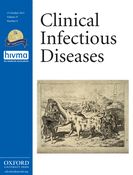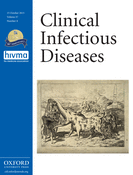
Cover image

On the cover: Vaccination. Etching by Charles Williams. 1802. British. Wellcome Library, London, UK. Reproduced with permission.
The attack of the antivaccination forces in the early 19th century was neither timid nor subtle. In response to the apparent efficacy of cowpox vaccination presented by Edward Jenner in 1796, Williams depicted the controversy with “Vaccination” as a single beast of botched taxonomy incorporating the anatomy of various animals used in vaccination attempts. Possessing cowlike horns, hind legs, and tail, the monster was complemented by the gaping jaws of a crocodile and the claws of a lion. Three doctors are throwing the contents of baskets filled with infants into the monster's jaws. The most prominent doctor's pocket contains a document (£10 000) showing that he is Jenner, to whom a parliamentary grant of that amount was made in June 1802. Once vaccinated, the infants are excreted, now bearing the same horns and tails as the doctors.
Forming the antivaccination forces, 5 armed men advancing in the middle distance prepare for battle with shields and swords inscribed with “Truth.” William Woodville (1752–1805) is presumed to be the provaccination doctor with a shovel. A physician to the smallpox hospital at St Pancras (see Clinical Infectious Diseases, 15 March 2012 cover), he was a strong supporter of Jenner.
(Mary & Michael Grizzard, Cover Art Editors)
Volume 57, Issue 8, 15 October 2013
NEWS
15 October News
IN THE LITERATURE
In the Literature
ARTICLES AND COMMENTARIES
High Morbidity and Mortality in Adults Hospitalized for Respiratory Syncytial Virus Infections
In a large hospital cohort, older adults with respiratory syncytial virus infections were shown to have high rates of lower respiratory tract complications (72%) and respiratory failure requiring assisted ventilation (>10%), prolonged hospitalization, and high mortality (>10%).
Editorial Commentary: Respiratory Syncytial Virus: A Global Pathogen in an Aging World
Epidemiology of Pyrazinamide-Resistant Tuberculosis in the United States, 1999–2009
In US jurisdictions routinely testing Mycobacterium tuberculosis complex for pyrazinamide susceptibility, pyrazinamide resistance increased from 2.0% to 3.3% per year during 1999–2009. Changing human and mycobacterial characteristics, including phylogenetic lineage of M. tuberculosis, were associated with this increase.
Use of Multilocus Variable Number of Tandem Repeats Analysis Genotyping to Determine the Role of Asymptomatic Carriers in Clostridium difficile Transmission
Multilocus variable number of tandem repeats analysis genotyping of Clostridium difficile isolates from screening tests and patients with symptomatic C. difficile infection reveals that asymptomatic carriers and environmental transmission from both carriers and patients with C. difficile infection contribute to new hospital-acquired cases.
Editorial Commentary: Looking to the Future: Vertical vs Horizontal Prevention of Clostridium difficile Infections
Lack of Homologous Protection Against Campylobacter jejuni CG8421 in a Human Challenge Model
In a human challenge model with Campylobacter jejuni CG8421, primary infection caused campylobacteriosis and immune responsiveness measured by specific immunoglobuling (Ig) A and IgG, antibody-secreting cells, fecal IgA, and interferon γ production. Unexpectedly, after rechallenge, subjects were not protected from clinical illness.
Case Definitions, Diagnostic Algorithms, and Priorities in Encephalitis: Consensus Statement of the International Encephalitis Consortium
We present a consensus document that proposes a standardized case definition and diagnostic guidelines for evaluation of adults and children with suspected encephalitis. In addition, areas of research priority, including host genetics and selected emerging infections, are discussed.
Escherichia coli O157:H7 Infections Associated With Consumption of Locally Grown Strawberries Contaminated by Deer
This article describes an outbreak of Escherichia coli O157:H7 illnesses associated with consumption of fresh strawberries contaminated by deer. The investigation identified a novel vehicle for E. coli O157:H7 infection and highlights problems concerning produce contamination by wildlife.
Editorial Commentary: Rapid Detection and Investigation of an Outbreak of Escherichia coli O157:H7 Infections: Shoe-leather Epidemiology on and Around the Strawberry Farm
Inhaled Corticosteroids and Risk of Recurrent Pneumonia: A Population-Based, Nested Case-Control Study
Among a population-based cohort of uniformly high-risk elderly patients who survived an episode of pneumonia, we observed a near 2-fold relative increase in risk (5% absolute risk increase) of recurrent pneumonia among patients currently using inhaled corticosteroids compared to nonusers.
REVIEW ARTICLE
Review of Infectious Diseases Applications for iPhone/iPad and Android: From Pocket to Patient
The explosion of medical apps creates challenges among providers trying to find reliable, trustworthy infectious diseases apps. This has opened the door for regulation by the Food and Drug Administration. We reviewed over 900 apps to find 11 new useful infectious diseases apps.
BRIEF REPORTS
Hookworm-Related Cutaneous Larva Migrans in Northern Brazil: Resolution of Clinical Pathology After a Single Dose of Ivermectin
Severe Hemorrhagic Meningoencephalitis Due to Angiostrongylus cantonensis Among Young Children in Sydney, Australia
PHOTO QUIZ
Pustular Skin Lesions in a Patient With Advanced HIV Infection and Pneumonia
INVITED ARTICLES
HIV/AIDS
The State of Engagement in HIV Care in the United States: From Cascade to Continuum to Control
More than 50% of persons diagnosed with human immunodeficiency virus (HIV) infection are not engaged in medical care and represent the greatest challenge and opportunity facing our domestic HIV epidemic. Conceptual frameworks, health implications, measurement and monitoring considerations, and evidence-based interventions are reviewed.
Editorial Commentary: A Tale of 2 Realities: What Are the Challenges and Solutions to Improving Engagement in HIV Care?
CLINICAL PRACTICE
Laboratory Diagnosis of Clostridium difficile Infections: There Is Light at the End of the Colon
Single molecular or multi-step assays (glutamate dehydrogenase, toxin A/B, +/− molecular) are recommended for the diagnosis of Clostridium difficile infections in patients with clinically significant diarrhea. Rapid and accurate tests can improve resource allocations and improve patient care. Enzyme immunoassay for toxins A/B is too insensitive for use as a stand-alone assay.
IMMUNOCOMPROMISED HOSTS
Rare and Emerging Viral Infections in Transplant Recipients
This review discusses the evolving field of viral discovery as well as emerging and reemerging viral pathogens that affect transplant recipients.
HIV/AIDS
Risk of QTc Prolongation in a Cohort of Opioid-Dependent HIV-Infected Patients on Methadone Maintenance Therapy
A high prevalence of prolonged QTc interval was shown in opioiddependent human immunodeficiency virus (HIV)–infected patients on methadone maintenance therapy. HIV patients with chronic hepatitis C–induced cirrhosis, antiretroviral-naive HIV patients, and those receiving higher doses of methadone are at increased risk for prolonged QTc interval.
Editorial Commentary: The Methadone Menace
The Impact of Combined Antiretroviral Therapy on Biologic False-Positive Rapid Plasma Reagin Serologies in a Longitudinal Cohort of HIV-Infected Persons
We found that combined antiretroviral therapy is associated with decreased odds of biologic false-positive reactions in persons with human immunodeficiency virus, perhaps as a result of improved B-cell function.
HIV Incidence Among Men With and Those Without Sexually Transmitted Rectal Infections: Estimates From Matching Against an HIV Case Registry
Human immunodeficiency virus (HIV)–negative men with rectal chlamydia and/or gonorrhea have an annual HIV incidence of 7%, which is 2.5 times the HIV risk of men without these infections. Findings can be used for targeting of interventions, such as preexposure prophylaxis for HIV prevention.
ANSWER TO THE PHOTO QUIZ
Pustular Skin Lesions in a Patient With Advanced HIV Infection and Pneumonia
CORRESPONDENCE
Use of Benzathine Penicillin in Treatment of Syphilis Among HIV-Discordant Couples in Zambia and Rwanda
Reply to Yang et al
Substitution Rates of the Internal Genes in the Novel Avian H7N9 Influenza Virus
Intervention to Limit Transmission of Extremely Drug-Resistant Acinetobacter baumannii in Patients Who Underwent Surgery
Use of Cephalexin Plus Trimethoprim/Sulfamethoxazole vs Cephalexin Alone for Treatment of Uncomplicated Cellulitis
Reply to Chou et al
Treating Patients With the Best Drugs
Reply to Parra-Ruiz
In Search of Useful Methods for Measuring Health and Economic Consequences of Antimicrobial Resistance
ERRATUM
Pasipanodya and Gumbo (Clin Infect Dis 2013; 57:21–31)
ELECTRONIC ARTICLE
Risk Factors for Measles Mortality Among Hospitalized Somali Refugees Displaced by Famine, Kenya, 2011
During a large laboratory-confirmed measles outbreak among refugees in Dadaab, Kenya, in 2011, 76% of hospitalizations due to measles and 67% of deaths among those patients occurred among adults. Measles mortality was significantly associated with neurological complications and acute malnutrition.



